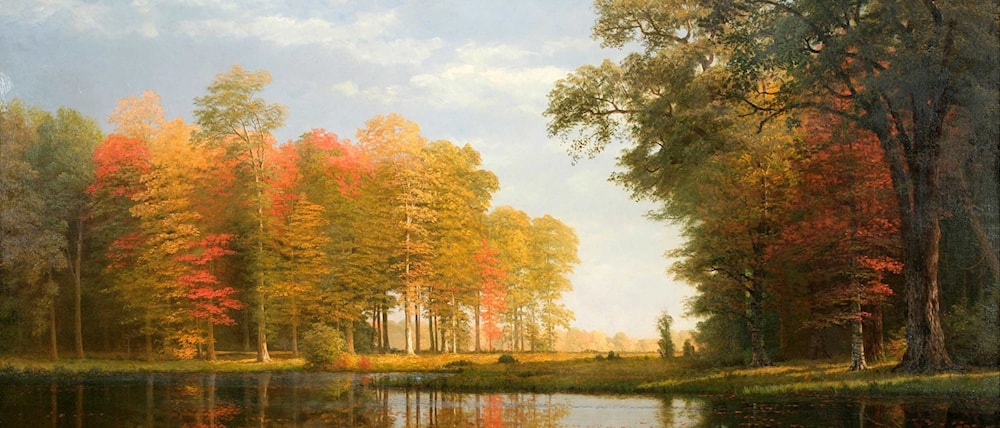Albert Bierstadt
Albert Bierstadt
283 artworks
American painter, photographer and landscape painter
Born 1830 - Died 1902
Born in Solingen (Düsseldorf, North Rhine-Westphalia, Germany)
Died in Irving (Chautauqua, New York state, United States)

{"Id":80,"Name":"Albert Bierstadt","Biography":"Recognized as the foremost painter of the American frontier during the nineteenth-century, Albert Bierstadt was born in Solingen, Germany, in 1830. At the age of two, he and his family emigrated to the United States, settling in New Bedford, Massachusetts. Nothing is known of his early art training; however, he might possibly have been influenced by local landscape painters anddaguerreotypists. By the time he was twenty, he was supporting himself by teaching \u0022monochromatic\u0022 painting and his work was beginning to attract the attention of New Bedford collectors.\u003Cbr\u003E\u003Cbr\u003EIn 1853, Bierstadt traveled to D\u0026uuml;sseldorf in order to broaden his art education. It was there that heassociated with such American artists as \u003Ca href=\u0022/asp/database/art.asp?aid=675\u0022 target=\u0022_blank\u0022 class=\u0022link\u0022\u003EWorthington Whittredge\u003C/a\u003E and \u003Ca href=\u0022/asp/database/art.asp?aid=2950\u0022 target=\u0022_blank\u0022 class=\u0022link\u0022\u003ECarl Wimar\u003C/a\u003E, all of whom frequently gathered in the studio of the German-American history painter, \u003Ca href=\u0022/asp/database/art.asp?aid=3948\u0022 target=\u0022_blank\u0022 class=\u0022link\u0022\u003EEmanuel Leutze\u003C/a\u003E. During this period, he was introduced to the work of Carl Friedrich Lessing and \u003Ca href=\u0022/asp/database/art.asp?aid=1798\u0022 target=\u0022_blank\u0022 class=\u0022link\u0022\u003EAndreas Aachenbach\u003C/a\u003E, contemporary German painters widely admired for their heroic, highly finished landscape compositions. Bierstadt quickly absorbed these stylistic conventions, eventually becoming the leading American representative of the D\u0026uuml;sseldorf style.\u003Cbr\u003E\u003Cbr\u003EWhile abroad, Bierstadt traveled along the Rhine, in the Alps and in Italy, often in the company of Whittredge, \u003Ca href=\u0022/asp/database/art.asp?aid=2030\u0022 target=\u0022_blank\u0022 class=\u0022link\u0022\u003ESanford Gifford\u003C/a\u003E and \u003Ca href=\u0022/asp/database/art.asp?aid=3897\u0022 target=\u0022_blank\u0022 class=\u0022link\u0022\u003EWilliam Stanley Haseltine\u003C/a\u003E. He returned to New Bedford in the autumn of 1857. In the following year, he made the first of his many contributions to the annual exhibitions of the National Academy of Design. In April of 1859, he joined the expedition along the Overland Trail, led by Colonel Frederick W. Lander, a trip that would soon give rise to the most productive and important phase of his career. Armed with sketches and stereographs, he returned to New York City in the autumn of 1859, establishing his studio in the Tenth Street Building. There he produced the first of the panoramic western landscapes that established his reputation on an international level and, during the mid-1860s, made him a rival of \u003Ca href=\u0022/asp/database/art.asp?aid=673\u0022 target=\u0022_blank\u0022 class=\u0022link\u0022\u003EFrederick Church\u003C/a\u003E for the position of America\u0027s preeminent painter.\u003Cbr\u003E\u003Cbr\u003EIndeed, because much of the continent remained still relatively unexplored at that time, Bierstadt\u0027s monumental renderings of stately mountains and cascading waterfalls created romantic visions of wanderlust in the minds of Easterners. His first public exhibition of these works in 1860 was a resounding success. Many critics deemed the viewing of his depictions as an almost \u0022religious\u0022 experience, associating his mountain spires with majestic cathedrals, his luminous skies with the awesome power of God. As pointed out by Barbara Novak, such works represent the attitude of the \u0022transcendental mind,\u0022 one in which\u0022all matter was an extension of God.\u0022\u003Cbr\u003E\u003Cbr\u003EBierstadt was elected a full Academician of the National Academy of Design in 1860. In the same year, he made several painting trips to the White Mountains as well as to the southern United States. He made a second trip to the West in 1863 which was followed by another visit to Europe in 1867. In 1871, he moved to California where he played an active role in the art life of San Francisco. In 1873, he returned toNew York.\u003Cbr\u003E\u003Cbr\u003EDuring the 1870s, Bierstadt executed a mural for the U.S. Capitol (1875) and in conjunction with the declining health of his wife, made the first of many trips to the Bahamas. He made a third trip toEurope in 1883. During 1889, he painted in both Alaska and British Columbia. He continued to produce landscapes throughout the 1890s. He also became involved in the promotion of various inventions,including his own designs for the improvement of railway cars.\u003Cbr\u003E\u003Cbr\u003EAlbert Bierstadt died in New York City in 1902. Although his reputation during the 1890s suffered slightly from the attraction for French art, his impact upon the American landscape tradition of thenineteenth century remains strong. His large-scale, panoramic landscapes, with their dramatic, almost sublime, light effects, coupled with the meticulous rendering of details, reflect the influences of both the contemporary landscape school of D\u0026uuml;sseldorf as well as the native Hudson River School aesthetic. His works can be found in major public and private collections throughout North America and Europe, including the Metropolitan Museum of Art, the Wadsworth Atheneum, and the National Gallery of Canada.\u003Cp\u003E","BiographicalImageUrl":null,"StartYear":1830,"EndYear":1902,"Awards":null,"HasAlbums":false,"HasPortraits":true,"HasRelationships":true,"HasArticles":false,"HasDepictedPlaces":true,"HasLetters":false,"HasLibraryItems":false,"HasProducts":true,"HasSignatures":false,"HasVideos":false,"HasMapLocations":true,"TotalArtworks":283}


